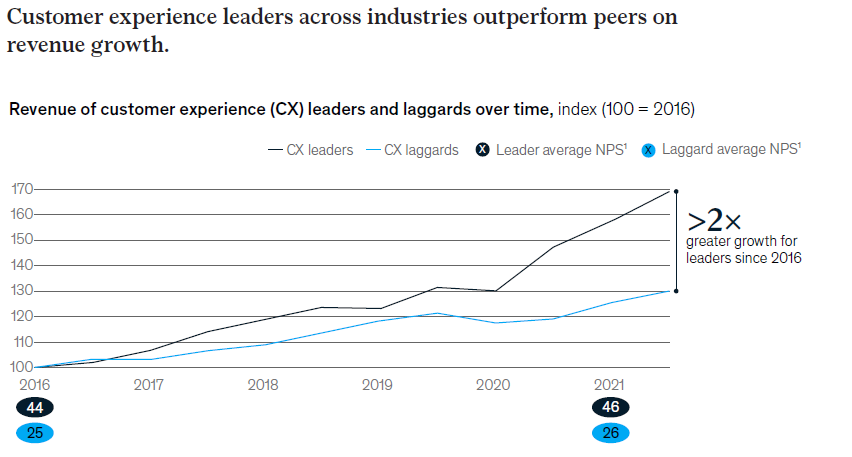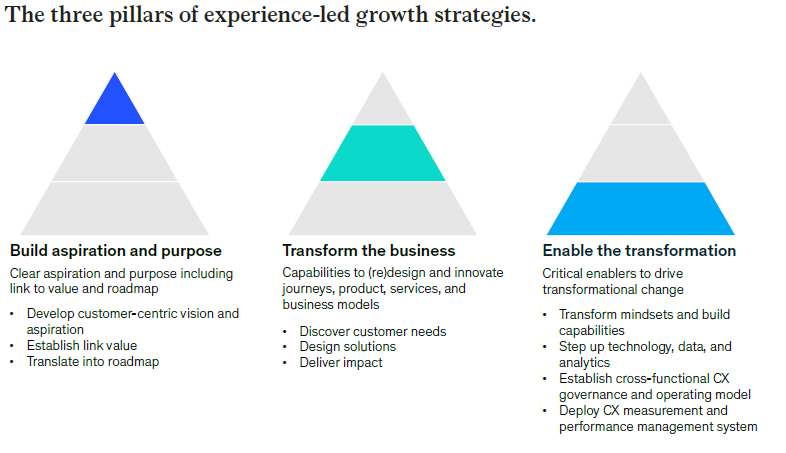

Why Experience-Led Growth Matters
Discover why experience-led growth is the key to sustainable success in 2025. Learn how prioritizing customer experience can drive loyalty, boost revenue, and give your brand a competitive edge in an increasingly commoditized world.


In a world increasingly driven by experience, focusing solely on short-term acquisition can trap companies in what experts call the “acquisition trap.”
This approach often leaves the existing customer base feeling overlooked and dissatisfied, causing them to look elsewhere.
Research has shown that companies that prioritize CX outperform their peers by delivering double the revenue growth. During the pandemic, these CX leaders also saw faster recovery, proving that experience-led growth is resilient, even in turbulent times.


In this blog, we’ll discuss:
Experience-led growth is a strategy for the long game.
Growth outperformers are more likely to deeply understand their customers, use predictive analytics, and make data-informed decisions to deliver the right messages at the right time. It’s not about quick wins; it’s about cultivating lasting loyalty by making it enjoyable and valuable for customers to use more of a company’s products and services.
Successful experience-led growth strategies rest on three core pillars:


Experience-led growth starts with a vision, often three to five years into the future, of how a company can meaningfully connect with customers and deliver on its brand promise.
But it’s not just about driving CX for its own sake.
Companies should set financial outcomes, such as boosting customer retention or increasing share of wallet, and then prioritize CX improvements that deliver these results.
A logistics company provides an inspiring example. Facing shrinking profit margins, the CEO realized that price hikes weren’t a sustainable growth path.
Instead, he focused on elevating CX. His team reimagined customer journeys, anchored experiences around the customer’s personal connection with their delivery driver, and created a culture of problem-solving and customer care. The transformation delivered substantial revenue growth, proving that customer value and experience-led growth are deeply intertwined.
Experience-led growth demands a company-wide commitment to CX.
Leaders must tackle pain points standing in the way of growth—such as confusing service processes or lack of integration across channels—and transform these into seamless customer journeys.
It’s about making CX a core part of the business model.
Large companies often need to realign their cultures and capabilities to sustain experience-led growth.
This shift requires upskilling executives and frontline staff, fostering cross-functional collaboration, and building robust CX measurement systems.
Capabilities such as design thinking, predictive analytics, and agile working methods ensure that CX initiatives deliver measurable, long-term value.
Consider a healthcare provider that launched a multi-year CX transformation.
By aggregating data and leveraging predictive analytics, they built models that could identify patients needing follow-up. This data-driven, proactive approach strengthened patient loyalty, demonstrating how CX’s capabilities can make a tangible difference in outcomes and revenue.
A study by HubSpot shows that 93% of customers are likely to make repeat purchases with companies that offer excellent customer service.
Experience-led growth isn’t about chasing the latest trend.
It’s a calculated, customer-centric strategy designed for sustainable success.
Companies that embrace experience-led growth outperform their peers by delivering 30% higher total return to shareholders (TRS) and generating nearly double the shareholder value.
Companies must focus on making every customer interaction memorable, meaningful, and measurable to succeed with experience-led growth. By embedding CX into the fabric of the business—from culture to technology—brands can cultivate deep customer loyalty, and customer experience, drive repeat purchases, and maximize revenue from their existing customer base.
In 2025, the companies leading in growth won’t necessarily be the ones with the most aggressive customer acquisition tactics. Instead, they’ll be the brands that have doubled down on their existing customers, creating loyalty by focusing on CX at every touchpoint. Experience-led growth is the key to sustainable success, and the companies that adopt this strategy will set themselves apart from their competitors in a meaningful way.
Are you ready to make experience-led growth your competitive advantage?
It’s time to turn customer loyalty into sustainable, profitable growth.
Don’t forget to share this post






Don’t Let Your Competitors Understand Your Customers Better Than You
Don’t miss out. Try our 30-day Free Professional Trial.

